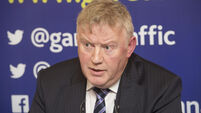‘Risks of a global freezing of markets are very real’
International Monetary Fund chief Christine Lagarde is heading to Berlin today to urge action after the IMF called for member states to provide €388bn for new loans to help troubled countries.
G20 officials say Europe must double the size of its rescue fund to $1 trillion as a crucial step to stabilise financial markets and prevent the euro-zone crisis from spreading. Europe finance ministers meet on their debt plan on Tuesday.
















